Last updated: May 31, 2021
Article
Vaux's Swift

Carl B. Jackson
General Description
“There it goes. First one in!” This is the cry Vaux’s swift observers wait for each night at sunset with their eyes trained on old brick chimney tops during fall and spring migration. The counting begins with the first swift’s entrance and continues as more swifts flutter and dive down into the roost, sometimes in a great rush of “chittering” bodies that may total in the thousands. Their human observers are not only enjoying one of nature’s marvels, they are also helping track the Vaux’s swift (Chaetura vauxi; pronounced “Vawks”) population numbers in the Pacific Northwest, which are declining.
The Vaux’s swift is a small (12 cm long; 4.75 in), light brownish, cigar shaped bird with long, slim, pointed wings that seem to be in constant motion. The swift’s agile, erratic flight is almost bat-like and gives the appearance of a swallow. Swallow wings are thicker at the base—more triangular looking—and can fold up close to the body in flight, unlike swifts. Swift wings stay extended because they flap from their “hands,” instead of “elbows,” like most other birds. This may help explain the optical illusion that swift wings beat alternately, or asynchronously, unlike the synchronous wingbeats of swallows. Lastly, if the bird perches on a branch, it is not a swift; swifts are not adapted for perching upright. Their short legs with tiny feet and long claws are built for clinging to a vertical surface, where the bird can brace, like a kick-stand, with its short, spine-tipped tail feathers. Swifts do not walk or hop, which is fitting for this smallest member in North America of the family, Apodidae, which means “no feet.” It lives almost entirely on the wing, except for roosting at night and nesting.
Habitat and Distribution
Migratory populations of the Vaux’s swift breed in the Pacific Northwest from British Columbia south through the coastal and central California mountains in coniferous or mixed forests. They prefer large diameter, hollow trees available in older forest for nest and roost sites. Broken off trunks and woodpecker excavations, especially those of the pileated woodpecker, create needed cavities. Coastal redwood forest also offers prime habitat. Urban breeders may occur where old, unlined brick chimneys from the 1940s and earlier offer a suitable nest substrate. Pacific Northwest birds migrate south throughout Central America to overwinter, overlapping with year-round residential populations of Vaux’s swifts. During fall and spring migration, Vaux’s swifts need roost sites large enough to accommodate up to thousands of these huddling, communal birds overnight. This mass roosting is presumably to conserve body heat when temperatures drop. Larger school or industrial-sized brick chimneys that retain rough (unlined) surfaces can substitute as habitat.
Predators
Vaux’s swifts fall prey to accipiters (forest hawks), falcons, owls, and presumably mammal predators. American crows (Corvus brachyrhynchos) have been known to perch on the edge of roost entrances and pick off swifts as they enter or leave.
Diet
Flying usually above the tree canopy or wet areas, Vaux’s swifts snap up insects and ballooning spiders (which ride wind currents by spider thread) with wide mouths and precision flight, as you might expect from a “swift.” Gathering the insects into a small food pouch (bolus) at the back of their throats, they can eat the ball or deliver it to nestlings. A single day’s catch numbers thousands of insects. Specific prey includes beetles, bees, ants, flies, planthoppers, mayflies, moths, and more.
Reproduction
Vaux’s swifts return to their Pacific Northwest breeding grounds by June to begin courtship and form monogamous pair bonds, though some nonreproducing adults may help with nesting duties. Courting pairs chase each other and glide with wings in a V shape. Amazingly, they mate in mid-air, falling downwards in a tangle until just above the ground. The female lays 3–6 white, jelly bean sized eggs in a nest of loose twigs glued against the wall by sticky saliva. Both adults incubate the eggs, which hatch 18 days later. Nestlings leave the nest in 20 days to cling to nearby walls, and fledge by 28 days. Parents get no rest, delivering 5000+ insects a day to the young. Fledglings join the fall migration and breed during the next spring.
Conservation
Vaux’s swift populations in the US and Canada have declined an estimated 50% since the late 1960s. Threats include the loss of large, old trees for nesting and roosting, as well as the demolition of old brick chimneys. VauxHappening.org conducts volunteer counts of Vaux’s swifts at important migration roosts, and works to preserve old, brick chimneys used by the swift. Audubon climate models predict a northward shift in breeding habitat for the Pacific Northwest populations, with some overall loss of habitat under all warming scenarios.
Where to See
Vaux’s swifts likely occur in all Klamath Network parks, either for migration or breeding. They are common breeders at Redwood National and State Parks.
Learn More

Download a pdf of this article.
Prepared by Sonya Daw
NPS Klamath Inventory & Monitoring Network
Southern Oregon University
1250 Siskiyou Blvd
Ashland, OR 97520
Featured Creature Edition: May 2021
